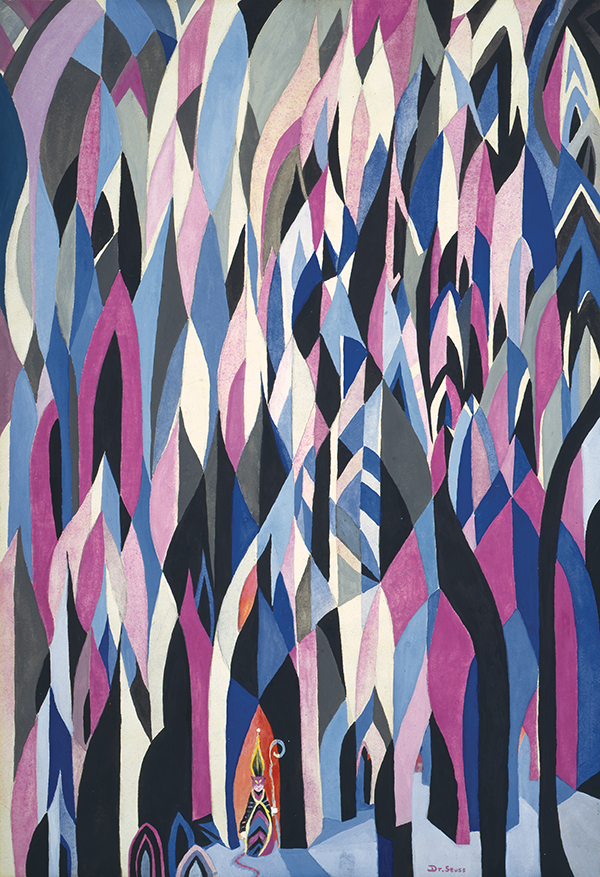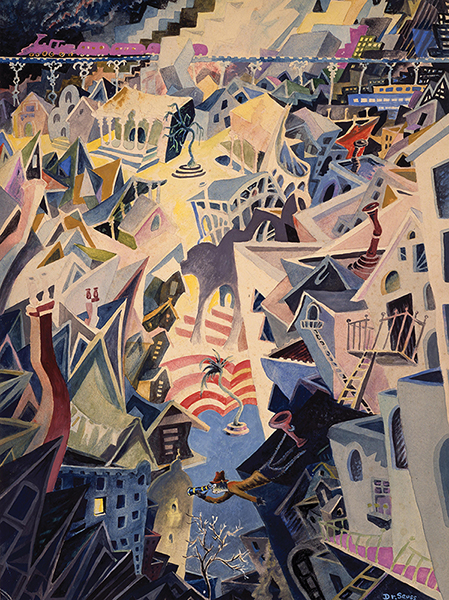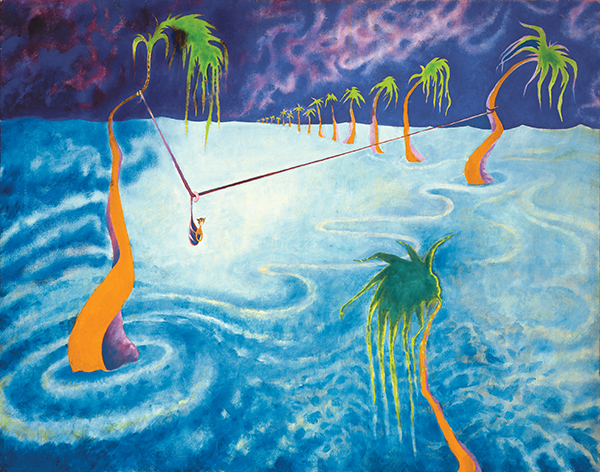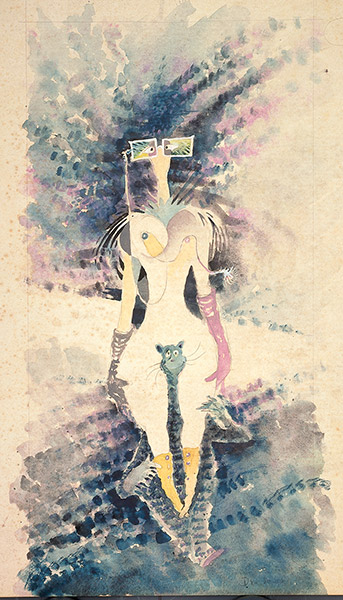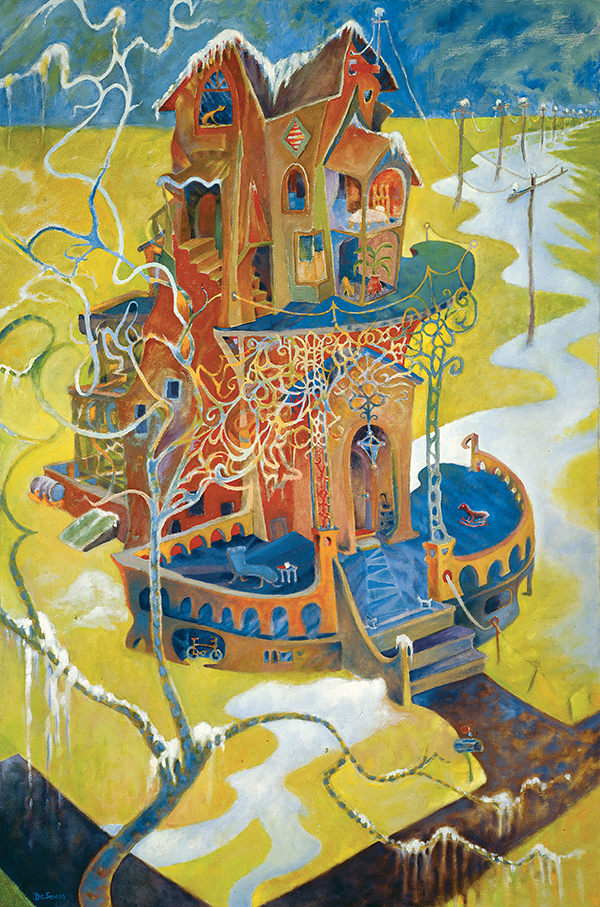Simply scroll through the page or click one of the links below to learn about this artwork.
SECRET CATS
A CRITIC'S PERSPECTIVE
ARTISTIC INFLUENCE
SERIOUSLY THERE'S FUN TO BE DONE!
Mixed-Media Pigment Print on Canvas, 36" x 28" with additional canvas border
Limited Edition of 850 Arabic Numbers, 99 Patrons' Collection, 155 Collaborators' Proofs and 5 Hors d'Commerce.
Secret Cats
Green Cat in Uleåborg Finland Subway joins an acclaimed group of Secret Cats from Ted Geisel’s extraordinarily personal collection of midnight paintings. Cats have taken center stage as a recurring theme in many of Ted’s most important and most sought-after artworks. Like a window into his soul, these works provide a behind-the-scenes look at Seuss the man and the artist. Some cats appear as bold portraits, while in the case of these works, the mostly hidden cats take supporting roles that cleverly punctuate or decode Dr. Seuss as the creator of these images. Ted’sSecret Cats are the ultimate expression of his personality, humor, and artistic inventiveness secreted within his most personal creations.
A Critic's Perspective
During the winter of 1976-77, Dr. Seuss was given a 6-week retrospective — “Who Is Dr. Seuss?” — at the La Jolla Museum of Contemporary Art. Most of the work shown was described by The San Diego Union’s art critic, Richard Reilly (1974-1983), as “new to his fans . . . created from the early 1930s to the present.” Reilly wrote a significant article, highlighting several of the artworks that were standouts for him, but the single piece he chose to print in the newspaper was Green Cat in Uleåborg Finland Subway.
““For the most part, it is Geisel’s impudent cats and preposterous creatures caught up in incongruous situations that overwhelm us for they are intellectual, yet offer an escape from reality and are so perfectly simple that children, the toughest of critics, adore them. Geisel’s tight, linear patterns, repeated again and again may express the bewilderment of humankind caught up in the maze of bureaucracy, and then again may just be a green cat lost in the subway.”
”
Artistic Influence
Ted Geisel himself said that, because of its draftsmanship, Green Cat in Uleåborg Finland Subway was as close as he came to “serious painting.” Throughout his career, he was known to draw inspiration from disparate cultural, literary or artistic influences. In 1964 when Green Cat in Uleåborg Finland Subway was created, "serious painting" included the genre of American modernism. As part of this movement, Frank Stella had found early and instantaneous recognition with his series of black striped images included in the “Sixteen Americans” exhibition at New York’s Museum of Modern Art in 1960. Stella, shown here in 1959 with Tomlinson Court Park, became a key figure in American modernism. Ted Geisel traveled regularly to New York during this time and the city’s cultural impact had an indelible impact on his work. Turn Green Cat in Uleåborg Finland Subway on its side and Stella's influence seems abundantly clear.
Frank Stella, 1959, with Tomlinson Court Park Green Cat in Uleåborg Finland Subway(1964)
Seriously, "There's Fun To Be Done!"
Uleåborg is the Swedish name for the Finnish city of Oulu, dubbed the “Capital of Northern Scandinavia.” What was it about Ted’s knowledge of this city that may have sparked his imagination? Outsiders say that there is something pure in the air there which makes Oulu vital and exciting. Subarctic summers of endless light are balanced by freezing, mostly dark, magical winters. There are lakes galore and fair-haired children everywhere. And if you travel north for an hour, away from ambient city lights, you’ll witness nature’s oldest and finest extravaganza—the Aurora Borealis.
But there is no subway.
These facts played right into Ted’s hand. The Seussian artistic norm—fantasy, not reality—had been set in stone after the debacle of his first and final high school art class where, “My teacher gave me hell for working on my picture upside down. ‘No Theodor, not upside down,’ she said. ‘There are rules that every artist must abide by. You will never succeed if you break them.’” From that point on “serious fun” became a way of life for Ted, as did breaking artistic rules. Whynot paint a green cat in the “Uleåborg Finland Subway,” especially if there is very little “green” in the city landscape and certainly no subway? This counterpoint was something he couldn’t resist embracing.
Close-up of the two signatures on Green Cat in Uleåborg Finland Subway.
Another Seussian break from tradition is the fact that Dr. Seuss signed Green Cat in Uleåborg Finland Subway twice; once firmly in purplish-blue just inside the outer border, and the other faintly in yellow in the lower left-hand corner of the largest geometric rectangle. This isn’t the only time the addition of a new element prompted him to include a second signature. When Ted put an antiqued window frame with a functioning hinge and screen on View from a Window of a Rented Beach Cottage, it covered his original signature, prompting him to resign the artwork. With Uleåborg Finland Subway the addition of the outer border took the piece to a different, more dramatic level, potentially demanding a stronger, more visible signature and Ted likely complied.



